Analysis and Design of Cloud-Based System for Headspace Application
VerifiedAdded on 2020/03/16
|11
|2417
|27
Report
AI Summary
This report provides a comprehensive analysis of system design and cloud computing solutions for Headspace, focusing on the storage and access of patient data. It begins by outlining non-functional requirements such as understandability, adaptability, and robustness, as well as system qualiti...
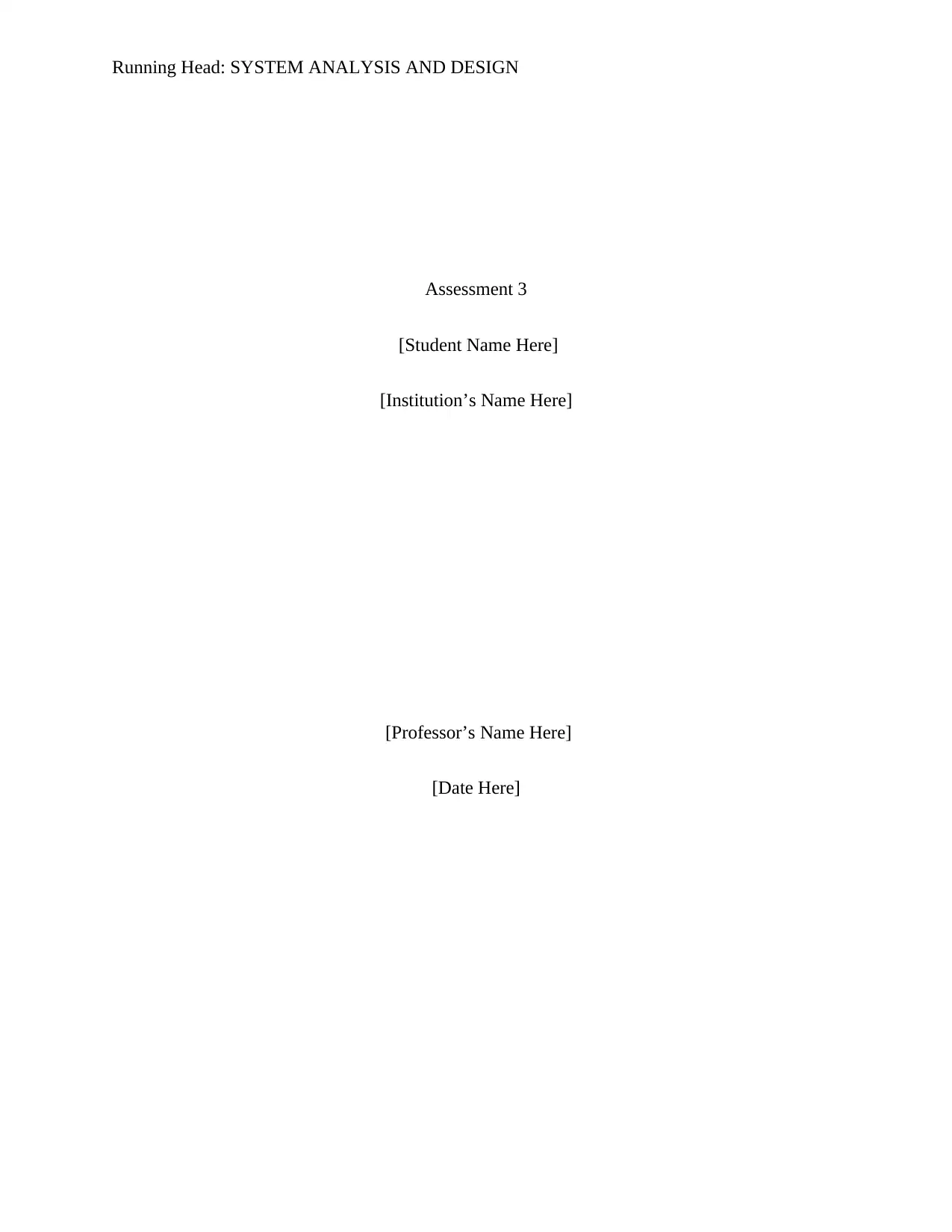
Running Head: SYSTEM ANALYSIS AND DESIGN
Assessment 3
[Student Name Here]
[Institution’s Name Here]
[Professor’s Name Here]
[Date Here]
Assessment 3
[Student Name Here]
[Institution’s Name Here]
[Professor’s Name Here]
[Date Here]
Paraphrase This Document
Need a fresh take? Get an instant paraphrase of this document with our AI Paraphraser
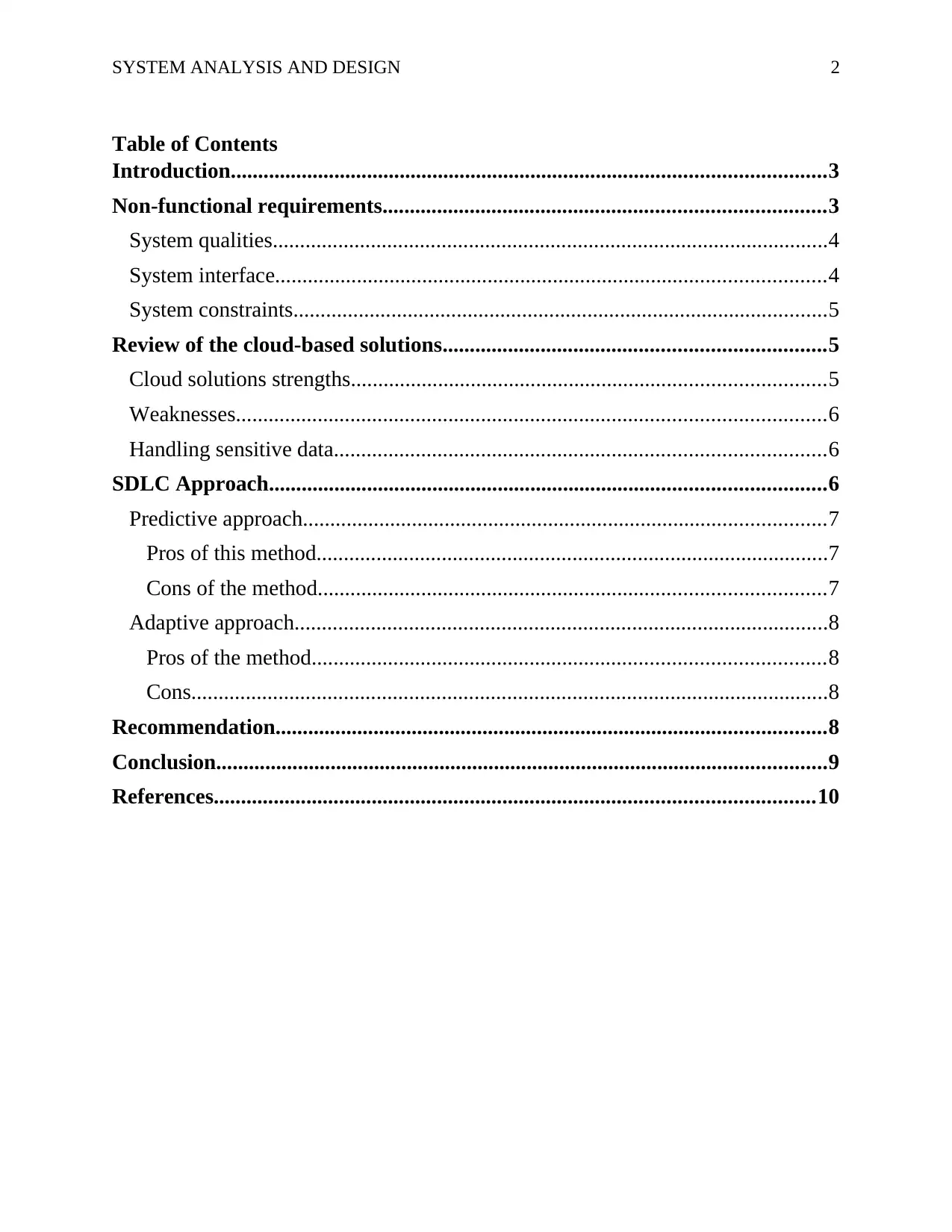
SYSTEM ANALYSIS AND DESIGN 2
Table of Contents
Introduction.............................................................................................................3
Non-functional requirements.................................................................................3
System qualities......................................................................................................4
System interface.....................................................................................................4
System constraints..................................................................................................5
Review of the cloud-based solutions......................................................................5
Cloud solutions strengths.......................................................................................5
Weaknesses............................................................................................................6
Handling sensitive data..........................................................................................6
SDLC Approach......................................................................................................6
Predictive approach................................................................................................7
Pros of this method..............................................................................................7
Cons of the method.............................................................................................7
Adaptive approach..................................................................................................8
Pros of the method..............................................................................................8
Cons.....................................................................................................................8
Recommendation.....................................................................................................8
Conclusion................................................................................................................9
References..............................................................................................................10
Table of Contents
Introduction.............................................................................................................3
Non-functional requirements.................................................................................3
System qualities......................................................................................................4
System interface.....................................................................................................4
System constraints..................................................................................................5
Review of the cloud-based solutions......................................................................5
Cloud solutions strengths.......................................................................................5
Weaknesses............................................................................................................6
Handling sensitive data..........................................................................................6
SDLC Approach......................................................................................................6
Predictive approach................................................................................................7
Pros of this method..............................................................................................7
Cons of the method.............................................................................................7
Adaptive approach..................................................................................................8
Pros of the method..............................................................................................8
Cons.....................................................................................................................8
Recommendation.....................................................................................................8
Conclusion................................................................................................................9
References..............................................................................................................10
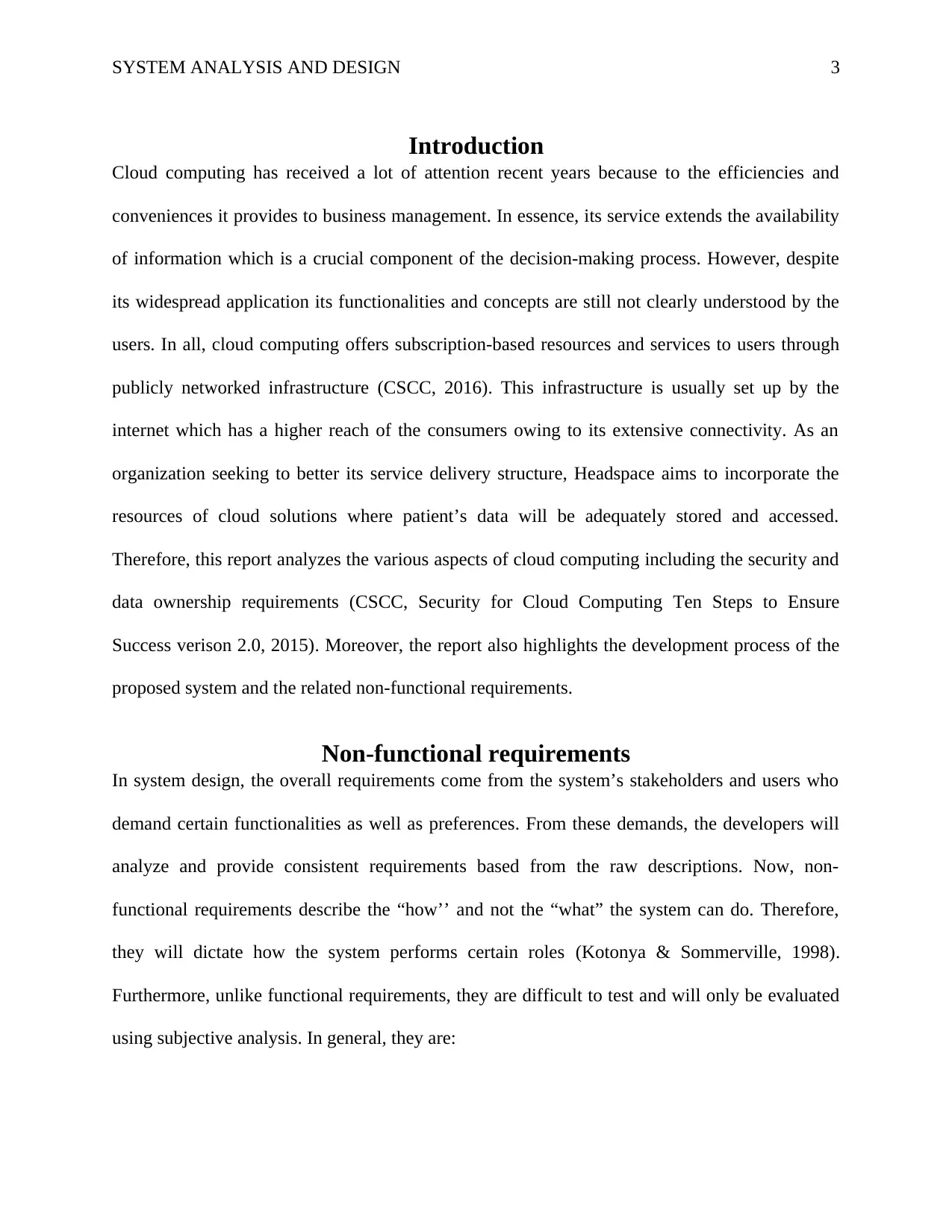
SYSTEM ANALYSIS AND DESIGN 3
Introduction
Cloud computing has received a lot of attention recent years because to the efficiencies and
conveniences it provides to business management. In essence, its service extends the availability
of information which is a crucial component of the decision-making process. However, despite
its widespread application its functionalities and concepts are still not clearly understood by the
users. In all, cloud computing offers subscription-based resources and services to users through
publicly networked infrastructure (CSCC, 2016). This infrastructure is usually set up by the
internet which has a higher reach of the consumers owing to its extensive connectivity. As an
organization seeking to better its service delivery structure, Headspace aims to incorporate the
resources of cloud solutions where patient’s data will be adequately stored and accessed.
Therefore, this report analyzes the various aspects of cloud computing including the security and
data ownership requirements (CSCC, Security for Cloud Computing Ten Steps to Ensure
Success verison 2.0, 2015). Moreover, the report also highlights the development process of the
proposed system and the related non-functional requirements.
Non-functional requirements
In system design, the overall requirements come from the system’s stakeholders and users who
demand certain functionalities as well as preferences. From these demands, the developers will
analyze and provide consistent requirements based from the raw descriptions. Now, non-
functional requirements describe the “how’’ and not the “what” the system can do. Therefore,
they will dictate how the system performs certain roles (Kotonya & Sommerville, 1998).
Furthermore, unlike functional requirements, they are difficult to test and will only be evaluated
using subjective analysis. In general, they are:
Introduction
Cloud computing has received a lot of attention recent years because to the efficiencies and
conveniences it provides to business management. In essence, its service extends the availability
of information which is a crucial component of the decision-making process. However, despite
its widespread application its functionalities and concepts are still not clearly understood by the
users. In all, cloud computing offers subscription-based resources and services to users through
publicly networked infrastructure (CSCC, 2016). This infrastructure is usually set up by the
internet which has a higher reach of the consumers owing to its extensive connectivity. As an
organization seeking to better its service delivery structure, Headspace aims to incorporate the
resources of cloud solutions where patient’s data will be adequately stored and accessed.
Therefore, this report analyzes the various aspects of cloud computing including the security and
data ownership requirements (CSCC, Security for Cloud Computing Ten Steps to Ensure
Success verison 2.0, 2015). Moreover, the report also highlights the development process of the
proposed system and the related non-functional requirements.
Non-functional requirements
In system design, the overall requirements come from the system’s stakeholders and users who
demand certain functionalities as well as preferences. From these demands, the developers will
analyze and provide consistent requirements based from the raw descriptions. Now, non-
functional requirements describe the “how’’ and not the “what” the system can do. Therefore,
they will dictate how the system performs certain roles (Kotonya & Sommerville, 1998).
Furthermore, unlike functional requirements, they are difficult to test and will only be evaluated
using subjective analysis. In general, they are:
⊘ This is a preview!⊘
Do you want full access?
Subscribe today to unlock all pages.

Trusted by 1+ million students worldwide
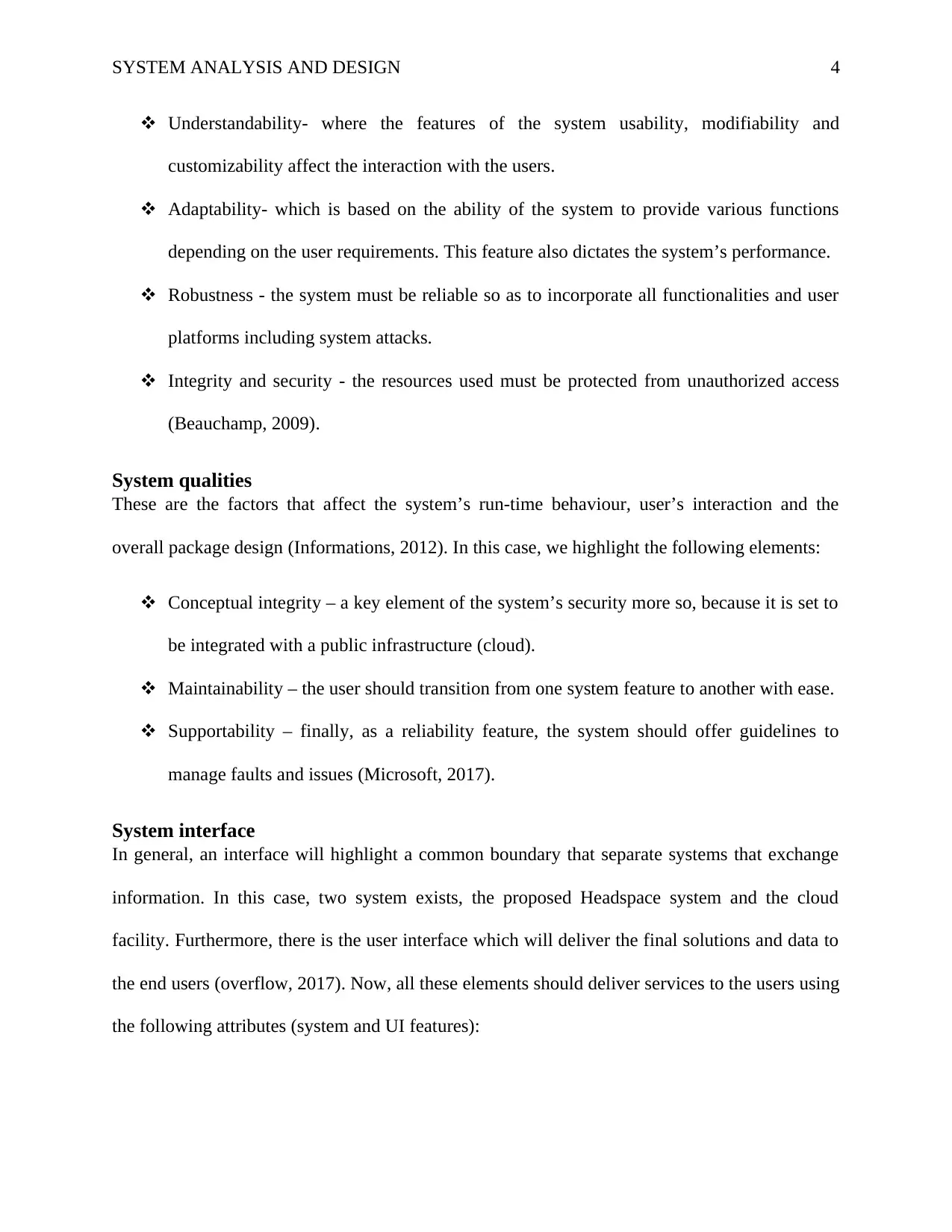
SYSTEM ANALYSIS AND DESIGN 4
Understandability- where the features of the system usability, modifiability and
customizability affect the interaction with the users.
Adaptability- which is based on the ability of the system to provide various functions
depending on the user requirements. This feature also dictates the system’s performance.
Robustness - the system must be reliable so as to incorporate all functionalities and user
platforms including system attacks.
Integrity and security - the resources used must be protected from unauthorized access
(Beauchamp, 2009).
System qualities
These are the factors that affect the system’s run-time behaviour, user’s interaction and the
overall package design (Informations, 2012). In this case, we highlight the following elements:
Conceptual integrity – a key element of the system’s security more so, because it is set to
be integrated with a public infrastructure (cloud).
Maintainability – the user should transition from one system feature to another with ease.
Supportability – finally, as a reliability feature, the system should offer guidelines to
manage faults and issues (Microsoft, 2017).
System interface
In general, an interface will highlight a common boundary that separate systems that exchange
information. In this case, two system exists, the proposed Headspace system and the cloud
facility. Furthermore, there is the user interface which will deliver the final solutions and data to
the end users (overflow, 2017). Now, all these elements should deliver services to the users using
the following attributes (system and UI features):
Understandability- where the features of the system usability, modifiability and
customizability affect the interaction with the users.
Adaptability- which is based on the ability of the system to provide various functions
depending on the user requirements. This feature also dictates the system’s performance.
Robustness - the system must be reliable so as to incorporate all functionalities and user
platforms including system attacks.
Integrity and security - the resources used must be protected from unauthorized access
(Beauchamp, 2009).
System qualities
These are the factors that affect the system’s run-time behaviour, user’s interaction and the
overall package design (Informations, 2012). In this case, we highlight the following elements:
Conceptual integrity – a key element of the system’s security more so, because it is set to
be integrated with a public infrastructure (cloud).
Maintainability – the user should transition from one system feature to another with ease.
Supportability – finally, as a reliability feature, the system should offer guidelines to
manage faults and issues (Microsoft, 2017).
System interface
In general, an interface will highlight a common boundary that separate systems that exchange
information. In this case, two system exists, the proposed Headspace system and the cloud
facility. Furthermore, there is the user interface which will deliver the final solutions and data to
the end users (overflow, 2017). Now, all these elements should deliver services to the users using
the following attributes (system and UI features):
Paraphrase This Document
Need a fresh take? Get an instant paraphrase of this document with our AI Paraphraser
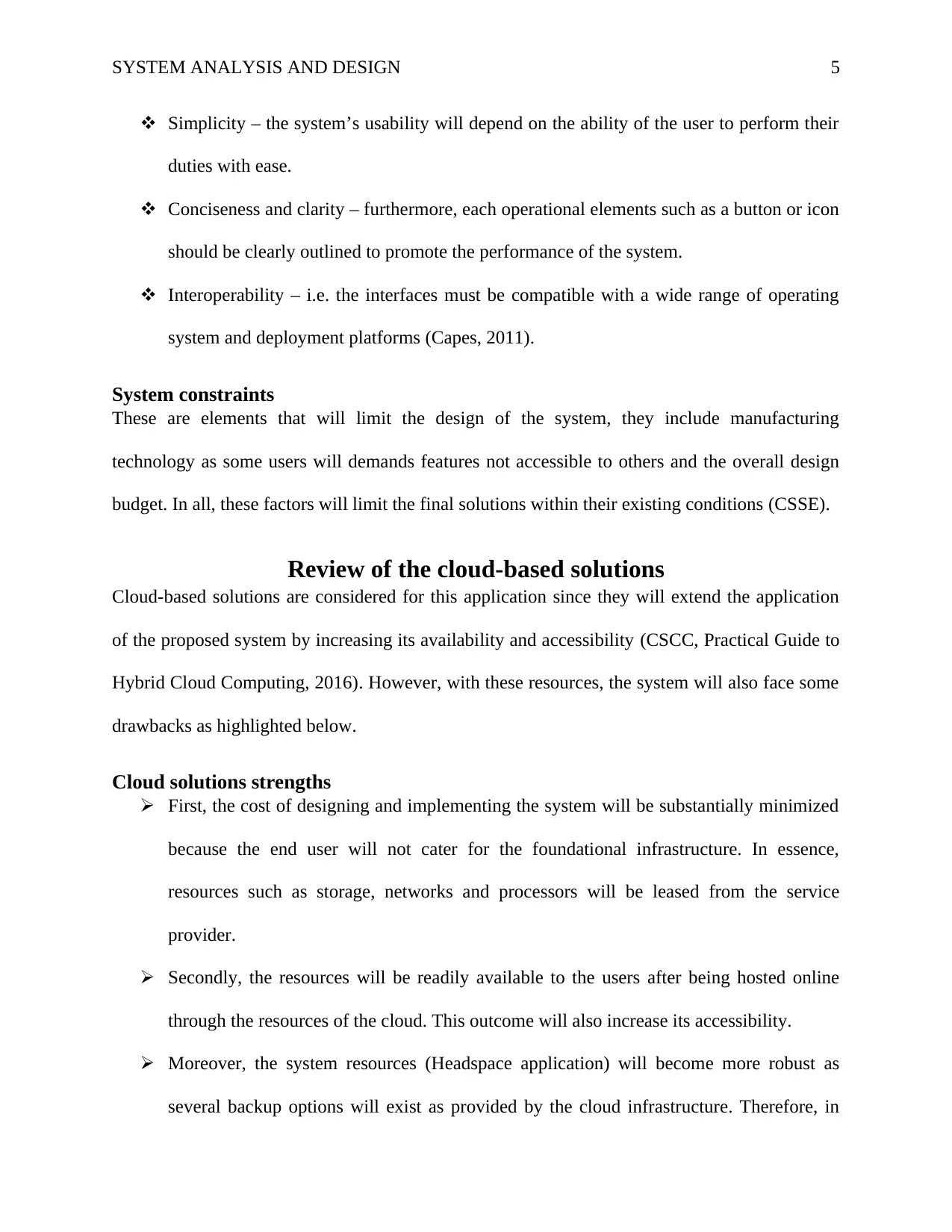
SYSTEM ANALYSIS AND DESIGN 5
Simplicity – the system’s usability will depend on the ability of the user to perform their
duties with ease.
Conciseness and clarity – furthermore, each operational elements such as a button or icon
should be clearly outlined to promote the performance of the system.
Interoperability – i.e. the interfaces must be compatible with a wide range of operating
system and deployment platforms (Capes, 2011).
System constraints
These are elements that will limit the design of the system, they include manufacturing
technology as some users will demands features not accessible to others and the overall design
budget. In all, these factors will limit the final solutions within their existing conditions (CSSE).
Review of the cloud-based solutions
Cloud-based solutions are considered for this application since they will extend the application
of the proposed system by increasing its availability and accessibility (CSCC, Practical Guide to
Hybrid Cloud Computing, 2016). However, with these resources, the system will also face some
drawbacks as highlighted below.
Cloud solutions strengths
First, the cost of designing and implementing the system will be substantially minimized
because the end user will not cater for the foundational infrastructure. In essence,
resources such as storage, networks and processors will be leased from the service
provider.
Secondly, the resources will be readily available to the users after being hosted online
through the resources of the cloud. This outcome will also increase its accessibility.
Moreover, the system resources (Headspace application) will become more robust as
several backup options will exist as provided by the cloud infrastructure. Therefore, in
Simplicity – the system’s usability will depend on the ability of the user to perform their
duties with ease.
Conciseness and clarity – furthermore, each operational elements such as a button or icon
should be clearly outlined to promote the performance of the system.
Interoperability – i.e. the interfaces must be compatible with a wide range of operating
system and deployment platforms (Capes, 2011).
System constraints
These are elements that will limit the design of the system, they include manufacturing
technology as some users will demands features not accessible to others and the overall design
budget. In all, these factors will limit the final solutions within their existing conditions (CSSE).
Review of the cloud-based solutions
Cloud-based solutions are considered for this application since they will extend the application
of the proposed system by increasing its availability and accessibility (CSCC, Practical Guide to
Hybrid Cloud Computing, 2016). However, with these resources, the system will also face some
drawbacks as highlighted below.
Cloud solutions strengths
First, the cost of designing and implementing the system will be substantially minimized
because the end user will not cater for the foundational infrastructure. In essence,
resources such as storage, networks and processors will be leased from the service
provider.
Secondly, the resources will be readily available to the users after being hosted online
through the resources of the cloud. This outcome will also increase its accessibility.
Moreover, the system resources (Headspace application) will become more robust as
several backup options will exist as provided by the cloud infrastructure. Therefore, in
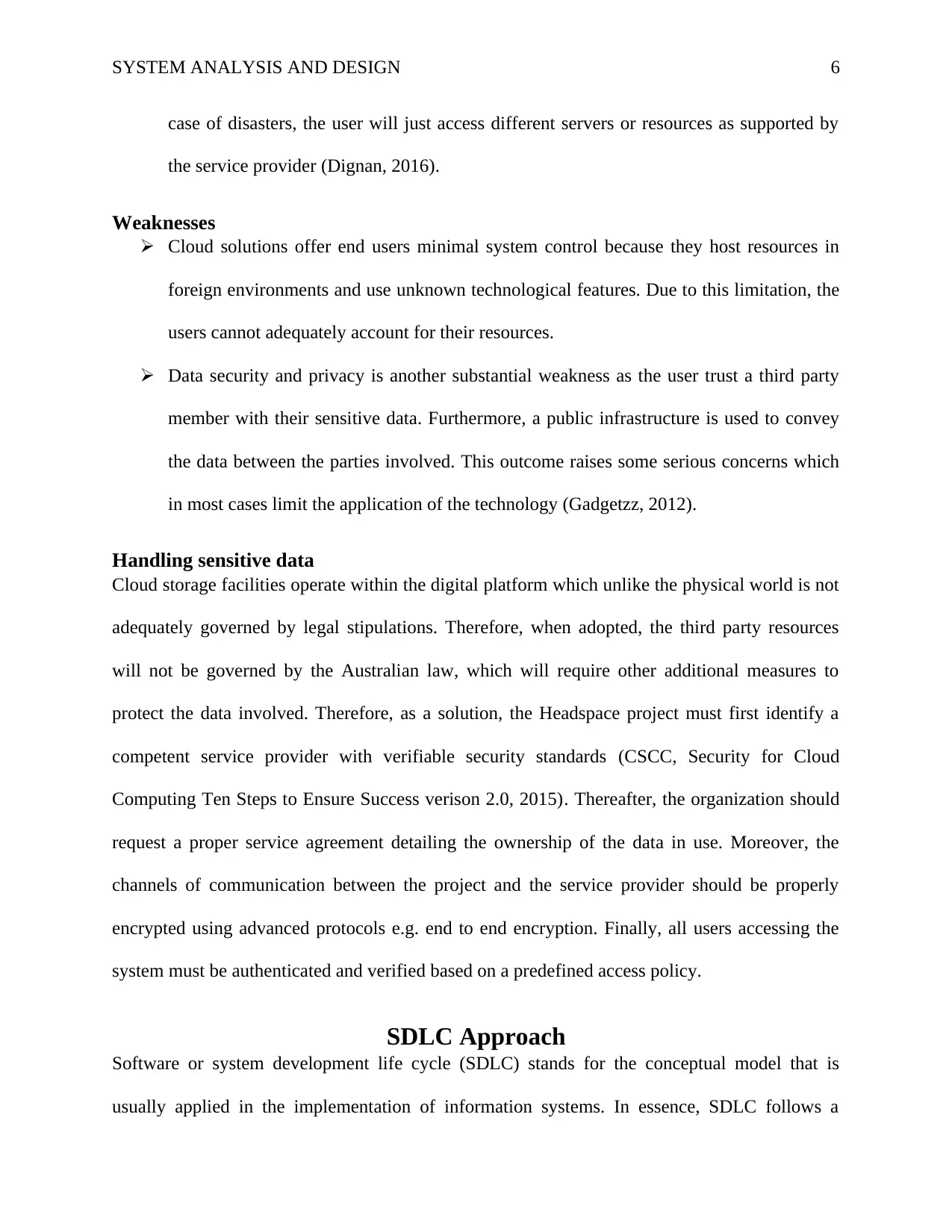
SYSTEM ANALYSIS AND DESIGN 6
case of disasters, the user will just access different servers or resources as supported by
the service provider (Dignan, 2016).
Weaknesses
Cloud solutions offer end users minimal system control because they host resources in
foreign environments and use unknown technological features. Due to this limitation, the
users cannot adequately account for their resources.
Data security and privacy is another substantial weakness as the user trust a third party
member with their sensitive data. Furthermore, a public infrastructure is used to convey
the data between the parties involved. This outcome raises some serious concerns which
in most cases limit the application of the technology (Gadgetzz, 2012).
Handling sensitive data
Cloud storage facilities operate within the digital platform which unlike the physical world is not
adequately governed by legal stipulations. Therefore, when adopted, the third party resources
will not be governed by the Australian law, which will require other additional measures to
protect the data involved. Therefore, as a solution, the Headspace project must first identify a
competent service provider with verifiable security standards (CSCC, Security for Cloud
Computing Ten Steps to Ensure Success verison 2.0, 2015). Thereafter, the organization should
request a proper service agreement detailing the ownership of the data in use. Moreover, the
channels of communication between the project and the service provider should be properly
encrypted using advanced protocols e.g. end to end encryption. Finally, all users accessing the
system must be authenticated and verified based on a predefined access policy.
SDLC Approach
Software or system development life cycle (SDLC) stands for the conceptual model that is
usually applied in the implementation of information systems. In essence, SDLC follows a
case of disasters, the user will just access different servers or resources as supported by
the service provider (Dignan, 2016).
Weaknesses
Cloud solutions offer end users minimal system control because they host resources in
foreign environments and use unknown technological features. Due to this limitation, the
users cannot adequately account for their resources.
Data security and privacy is another substantial weakness as the user trust a third party
member with their sensitive data. Furthermore, a public infrastructure is used to convey
the data between the parties involved. This outcome raises some serious concerns which
in most cases limit the application of the technology (Gadgetzz, 2012).
Handling sensitive data
Cloud storage facilities operate within the digital platform which unlike the physical world is not
adequately governed by legal stipulations. Therefore, when adopted, the third party resources
will not be governed by the Australian law, which will require other additional measures to
protect the data involved. Therefore, as a solution, the Headspace project must first identify a
competent service provider with verifiable security standards (CSCC, Security for Cloud
Computing Ten Steps to Ensure Success verison 2.0, 2015). Thereafter, the organization should
request a proper service agreement detailing the ownership of the data in use. Moreover, the
channels of communication between the project and the service provider should be properly
encrypted using advanced protocols e.g. end to end encryption. Finally, all users accessing the
system must be authenticated and verified based on a predefined access policy.
SDLC Approach
Software or system development life cycle (SDLC) stands for the conceptual model that is
usually applied in the implementation of information systems. In essence, SDLC follows a
⊘ This is a preview!⊘
Do you want full access?
Subscribe today to unlock all pages.

Trusted by 1+ million students worldwide
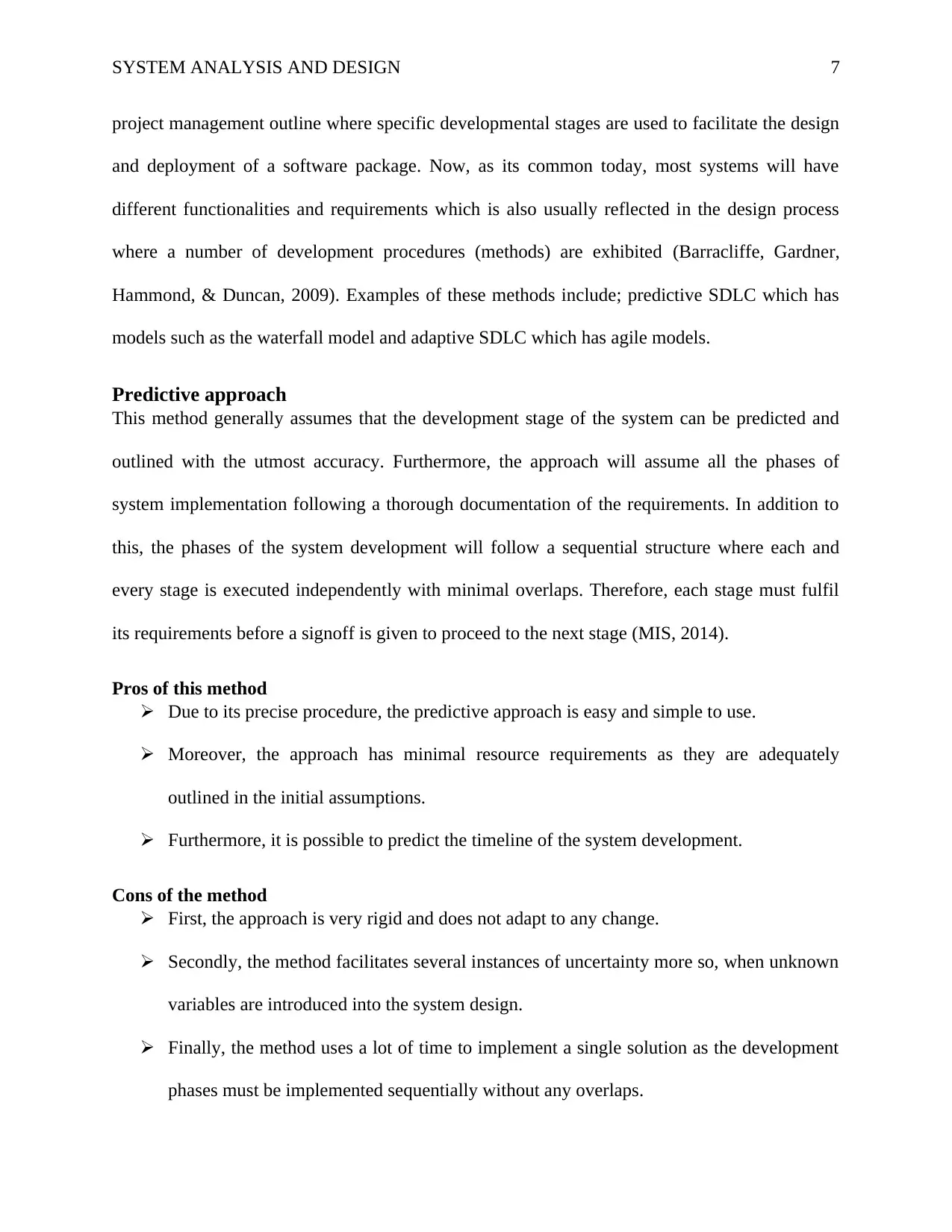
SYSTEM ANALYSIS AND DESIGN 7
project management outline where specific developmental stages are used to facilitate the design
and deployment of a software package. Now, as its common today, most systems will have
different functionalities and requirements which is also usually reflected in the design process
where a number of development procedures (methods) are exhibited (Barracliffe, Gardner,
Hammond, & Duncan, 2009). Examples of these methods include; predictive SDLC which has
models such as the waterfall model and adaptive SDLC which has agile models.
Predictive approach
This method generally assumes that the development stage of the system can be predicted and
outlined with the utmost accuracy. Furthermore, the approach will assume all the phases of
system implementation following a thorough documentation of the requirements. In addition to
this, the phases of the system development will follow a sequential structure where each and
every stage is executed independently with minimal overlaps. Therefore, each stage must fulfil
its requirements before a signoff is given to proceed to the next stage (MIS, 2014).
Pros of this method
Due to its precise procedure, the predictive approach is easy and simple to use.
Moreover, the approach has minimal resource requirements as they are adequately
outlined in the initial assumptions.
Furthermore, it is possible to predict the timeline of the system development.
Cons of the method
First, the approach is very rigid and does not adapt to any change.
Secondly, the method facilitates several instances of uncertainty more so, when unknown
variables are introduced into the system design.
Finally, the method uses a lot of time to implement a single solution as the development
phases must be implemented sequentially without any overlaps.
project management outline where specific developmental stages are used to facilitate the design
and deployment of a software package. Now, as its common today, most systems will have
different functionalities and requirements which is also usually reflected in the design process
where a number of development procedures (methods) are exhibited (Barracliffe, Gardner,
Hammond, & Duncan, 2009). Examples of these methods include; predictive SDLC which has
models such as the waterfall model and adaptive SDLC which has agile models.
Predictive approach
This method generally assumes that the development stage of the system can be predicted and
outlined with the utmost accuracy. Furthermore, the approach will assume all the phases of
system implementation following a thorough documentation of the requirements. In addition to
this, the phases of the system development will follow a sequential structure where each and
every stage is executed independently with minimal overlaps. Therefore, each stage must fulfil
its requirements before a signoff is given to proceed to the next stage (MIS, 2014).
Pros of this method
Due to its precise procedure, the predictive approach is easy and simple to use.
Moreover, the approach has minimal resource requirements as they are adequately
outlined in the initial assumptions.
Furthermore, it is possible to predict the timeline of the system development.
Cons of the method
First, the approach is very rigid and does not adapt to any change.
Secondly, the method facilitates several instances of uncertainty more so, when unknown
variables are introduced into the system design.
Finally, the method uses a lot of time to implement a single solution as the development
phases must be implemented sequentially without any overlaps.
Paraphrase This Document
Need a fresh take? Get an instant paraphrase of this document with our AI Paraphraser
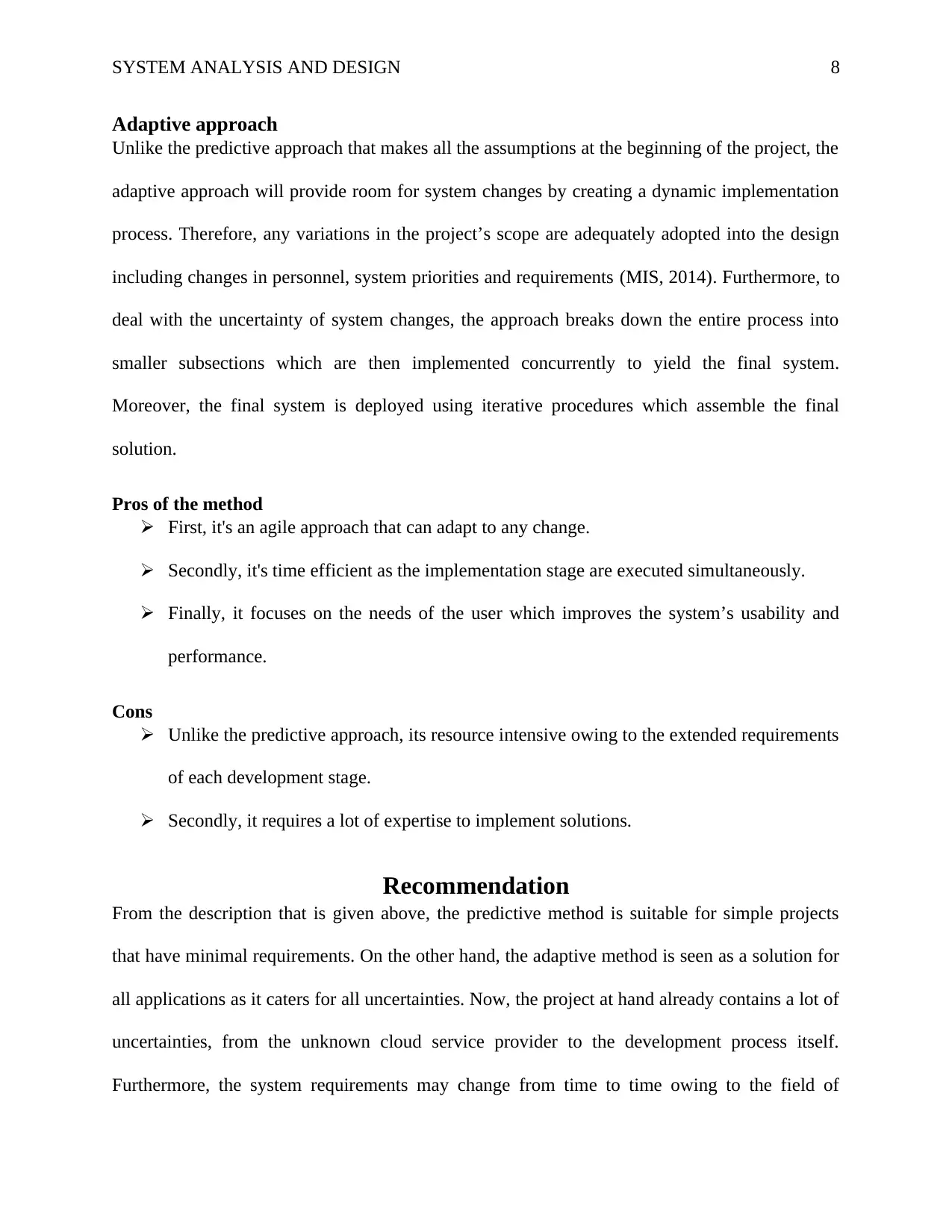
SYSTEM ANALYSIS AND DESIGN 8
Adaptive approach
Unlike the predictive approach that makes all the assumptions at the beginning of the project, the
adaptive approach will provide room for system changes by creating a dynamic implementation
process. Therefore, any variations in the project’s scope are adequately adopted into the design
including changes in personnel, system priorities and requirements (MIS, 2014). Furthermore, to
deal with the uncertainty of system changes, the approach breaks down the entire process into
smaller subsections which are then implemented concurrently to yield the final system.
Moreover, the final system is deployed using iterative procedures which assemble the final
solution.
Pros of the method
First, it's an agile approach that can adapt to any change.
Secondly, it's time efficient as the implementation stage are executed simultaneously.
Finally, it focuses on the needs of the user which improves the system’s usability and
performance.
Cons
Unlike the predictive approach, its resource intensive owing to the extended requirements
of each development stage.
Secondly, it requires a lot of expertise to implement solutions.
Recommendation
From the description that is given above, the predictive method is suitable for simple projects
that have minimal requirements. On the other hand, the adaptive method is seen as a solution for
all applications as it caters for all uncertainties. Now, the project at hand already contains a lot of
uncertainties, from the unknown cloud service provider to the development process itself.
Furthermore, the system requirements may change from time to time owing to the field of
Adaptive approach
Unlike the predictive approach that makes all the assumptions at the beginning of the project, the
adaptive approach will provide room for system changes by creating a dynamic implementation
process. Therefore, any variations in the project’s scope are adequately adopted into the design
including changes in personnel, system priorities and requirements (MIS, 2014). Furthermore, to
deal with the uncertainty of system changes, the approach breaks down the entire process into
smaller subsections which are then implemented concurrently to yield the final system.
Moreover, the final system is deployed using iterative procedures which assemble the final
solution.
Pros of the method
First, it's an agile approach that can adapt to any change.
Secondly, it's time efficient as the implementation stage are executed simultaneously.
Finally, it focuses on the needs of the user which improves the system’s usability and
performance.
Cons
Unlike the predictive approach, its resource intensive owing to the extended requirements
of each development stage.
Secondly, it requires a lot of expertise to implement solutions.
Recommendation
From the description that is given above, the predictive method is suitable for simple projects
that have minimal requirements. On the other hand, the adaptive method is seen as a solution for
all applications as it caters for all uncertainties. Now, the project at hand already contains a lot of
uncertainties, from the unknown cloud service provider to the development process itself.
Furthermore, the system requirements may change from time to time owing to the field of
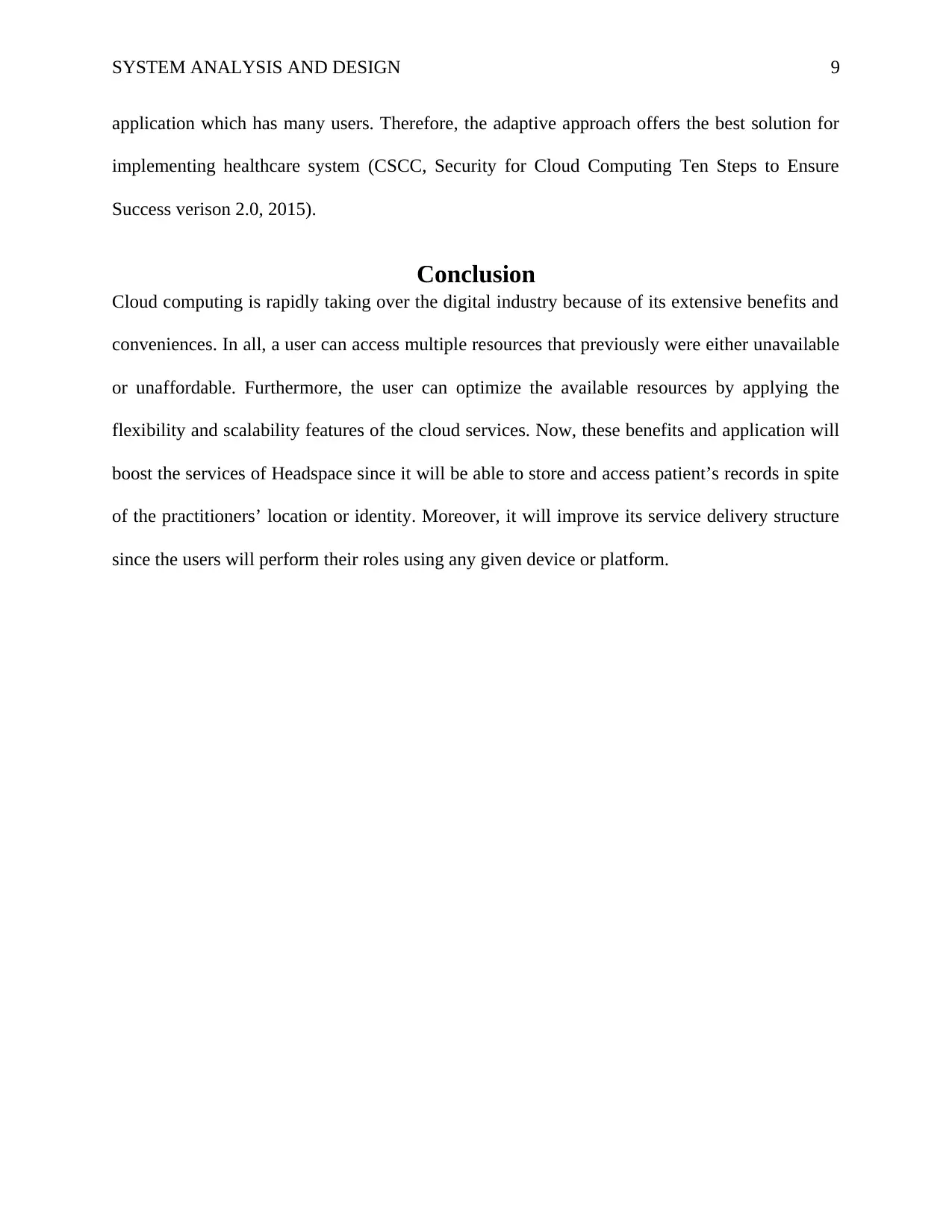
SYSTEM ANALYSIS AND DESIGN 9
application which has many users. Therefore, the adaptive approach offers the best solution for
implementing healthcare system (CSCC, Security for Cloud Computing Ten Steps to Ensure
Success verison 2.0, 2015).
Conclusion
Cloud computing is rapidly taking over the digital industry because of its extensive benefits and
conveniences. In all, a user can access multiple resources that previously were either unavailable
or unaffordable. Furthermore, the user can optimize the available resources by applying the
flexibility and scalability features of the cloud services. Now, these benefits and application will
boost the services of Headspace since it will be able to store and access patient’s records in spite
of the practitioners’ location or identity. Moreover, it will improve its service delivery structure
since the users will perform their roles using any given device or platform.
application which has many users. Therefore, the adaptive approach offers the best solution for
implementing healthcare system (CSCC, Security for Cloud Computing Ten Steps to Ensure
Success verison 2.0, 2015).
Conclusion
Cloud computing is rapidly taking over the digital industry because of its extensive benefits and
conveniences. In all, a user can access multiple resources that previously were either unavailable
or unaffordable. Furthermore, the user can optimize the available resources by applying the
flexibility and scalability features of the cloud services. Now, these benefits and application will
boost the services of Headspace since it will be able to store and access patient’s records in spite
of the practitioners’ location or identity. Moreover, it will improve its service delivery structure
since the users will perform their roles using any given device or platform.
⊘ This is a preview!⊘
Do you want full access?
Subscribe today to unlock all pages.

Trusted by 1+ million students worldwide
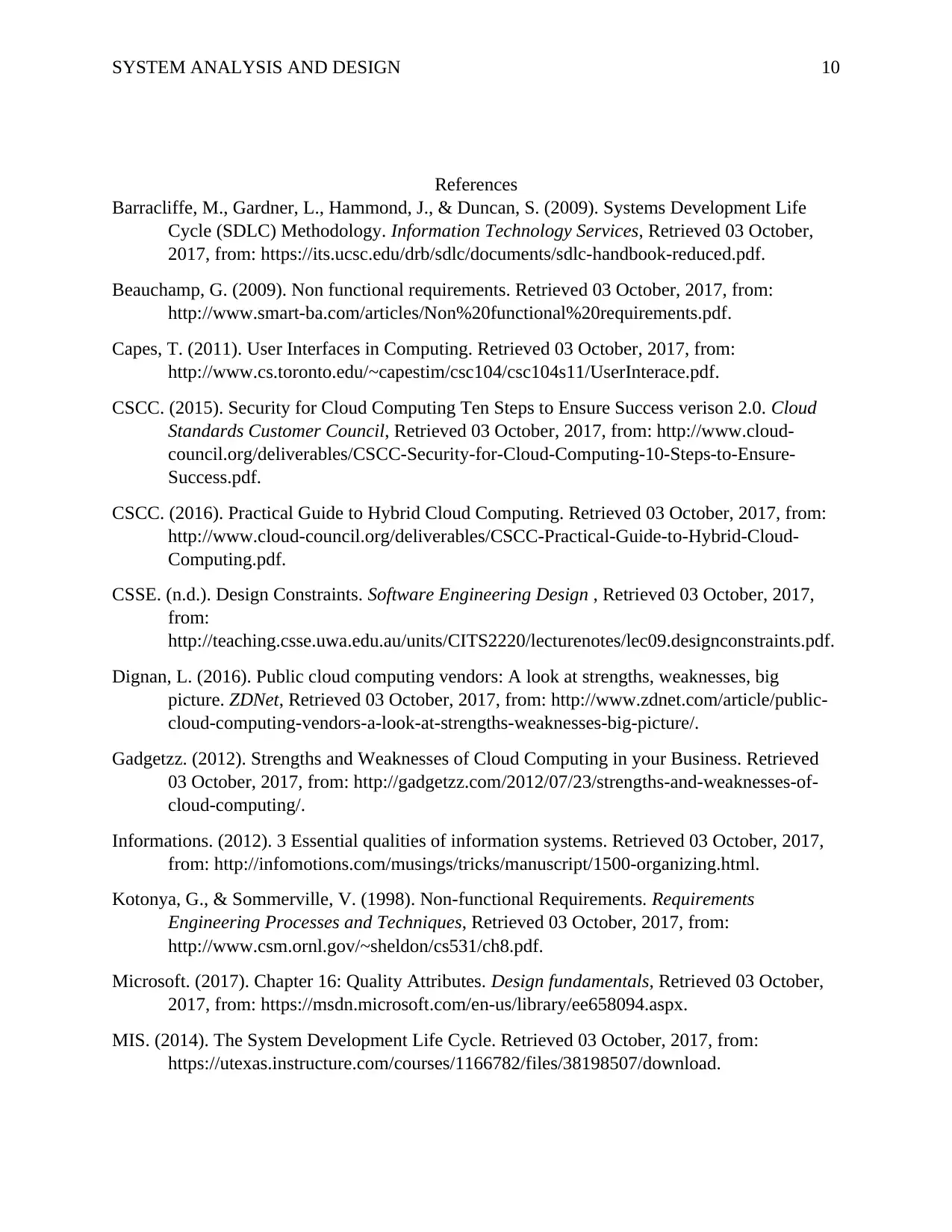
SYSTEM ANALYSIS AND DESIGN 10
References
Barracliffe, M., Gardner, L., Hammond, J., & Duncan, S. (2009). Systems Development Life
Cycle (SDLC) Methodology. Information Technology Services, Retrieved 03 October,
2017, from: https://its.ucsc.edu/drb/sdlc/documents/sdlc-handbook-reduced.pdf.
Beauchamp, G. (2009). Non functional requirements. Retrieved 03 October, 2017, from:
http://www.smart-ba.com/articles/Non%20functional%20requirements.pdf.
Capes, T. (2011). User Interfaces in Computing. Retrieved 03 October, 2017, from:
http://www.cs.toronto.edu/~capestim/csc104/csc104s11/UserInterace.pdf.
CSCC. (2015). Security for Cloud Computing Ten Steps to Ensure Success verison 2.0. Cloud
Standards Customer Council, Retrieved 03 October, 2017, from: http://www.cloud-
council.org/deliverables/CSCC-Security-for-Cloud-Computing-10-Steps-to-Ensure-
Success.pdf.
CSCC. (2016). Practical Guide to Hybrid Cloud Computing. Retrieved 03 October, 2017, from:
http://www.cloud-council.org/deliverables/CSCC-Practical-Guide-to-Hybrid-Cloud-
Computing.pdf.
CSSE. (n.d.). Design Constraints. Software Engineering Design , Retrieved 03 October, 2017,
from:
http://teaching.csse.uwa.edu.au/units/CITS2220/lecturenotes/lec09.designconstraints.pdf.
Dignan, L. (2016). Public cloud computing vendors: A look at strengths, weaknesses, big
picture. ZDNet, Retrieved 03 October, 2017, from: http://www.zdnet.com/article/public-
cloud-computing-vendors-a-look-at-strengths-weaknesses-big-picture/.
Gadgetzz. (2012). Strengths and Weaknesses of Cloud Computing in your Business. Retrieved
03 October, 2017, from: http://gadgetzz.com/2012/07/23/strengths-and-weaknesses-of-
cloud-computing/.
Informations. (2012). 3 Essential qualities of information systems. Retrieved 03 October, 2017,
from: http://infomotions.com/musings/tricks/manuscript/1500-organizing.html.
Kotonya, G., & Sommerville, V. (1998). Non-functional Requirements. Requirements
Engineering Processes and Techniques, Retrieved 03 October, 2017, from:
http://www.csm.ornl.gov/~sheldon/cs531/ch8.pdf.
Microsoft. (2017). Chapter 16: Quality Attributes. Design fundamentals, Retrieved 03 October,
2017, from: https://msdn.microsoft.com/en-us/library/ee658094.aspx.
MIS. (2014). The System Development Life Cycle. Retrieved 03 October, 2017, from:
https://utexas.instructure.com/courses/1166782/files/38198507/download.
References
Barracliffe, M., Gardner, L., Hammond, J., & Duncan, S. (2009). Systems Development Life
Cycle (SDLC) Methodology. Information Technology Services, Retrieved 03 October,
2017, from: https://its.ucsc.edu/drb/sdlc/documents/sdlc-handbook-reduced.pdf.
Beauchamp, G. (2009). Non functional requirements. Retrieved 03 October, 2017, from:
http://www.smart-ba.com/articles/Non%20functional%20requirements.pdf.
Capes, T. (2011). User Interfaces in Computing. Retrieved 03 October, 2017, from:
http://www.cs.toronto.edu/~capestim/csc104/csc104s11/UserInterace.pdf.
CSCC. (2015). Security for Cloud Computing Ten Steps to Ensure Success verison 2.0. Cloud
Standards Customer Council, Retrieved 03 October, 2017, from: http://www.cloud-
council.org/deliverables/CSCC-Security-for-Cloud-Computing-10-Steps-to-Ensure-
Success.pdf.
CSCC. (2016). Practical Guide to Hybrid Cloud Computing. Retrieved 03 October, 2017, from:
http://www.cloud-council.org/deliverables/CSCC-Practical-Guide-to-Hybrid-Cloud-
Computing.pdf.
CSSE. (n.d.). Design Constraints. Software Engineering Design , Retrieved 03 October, 2017,
from:
http://teaching.csse.uwa.edu.au/units/CITS2220/lecturenotes/lec09.designconstraints.pdf.
Dignan, L. (2016). Public cloud computing vendors: A look at strengths, weaknesses, big
picture. ZDNet, Retrieved 03 October, 2017, from: http://www.zdnet.com/article/public-
cloud-computing-vendors-a-look-at-strengths-weaknesses-big-picture/.
Gadgetzz. (2012). Strengths and Weaknesses of Cloud Computing in your Business. Retrieved
03 October, 2017, from: http://gadgetzz.com/2012/07/23/strengths-and-weaknesses-of-
cloud-computing/.
Informations. (2012). 3 Essential qualities of information systems. Retrieved 03 October, 2017,
from: http://infomotions.com/musings/tricks/manuscript/1500-organizing.html.
Kotonya, G., & Sommerville, V. (1998). Non-functional Requirements. Requirements
Engineering Processes and Techniques, Retrieved 03 October, 2017, from:
http://www.csm.ornl.gov/~sheldon/cs531/ch8.pdf.
Microsoft. (2017). Chapter 16: Quality Attributes. Design fundamentals, Retrieved 03 October,
2017, from: https://msdn.microsoft.com/en-us/library/ee658094.aspx.
MIS. (2014). The System Development Life Cycle. Retrieved 03 October, 2017, from:
https://utexas.instructure.com/courses/1166782/files/38198507/download.
Paraphrase This Document
Need a fresh take? Get an instant paraphrase of this document with our AI Paraphraser
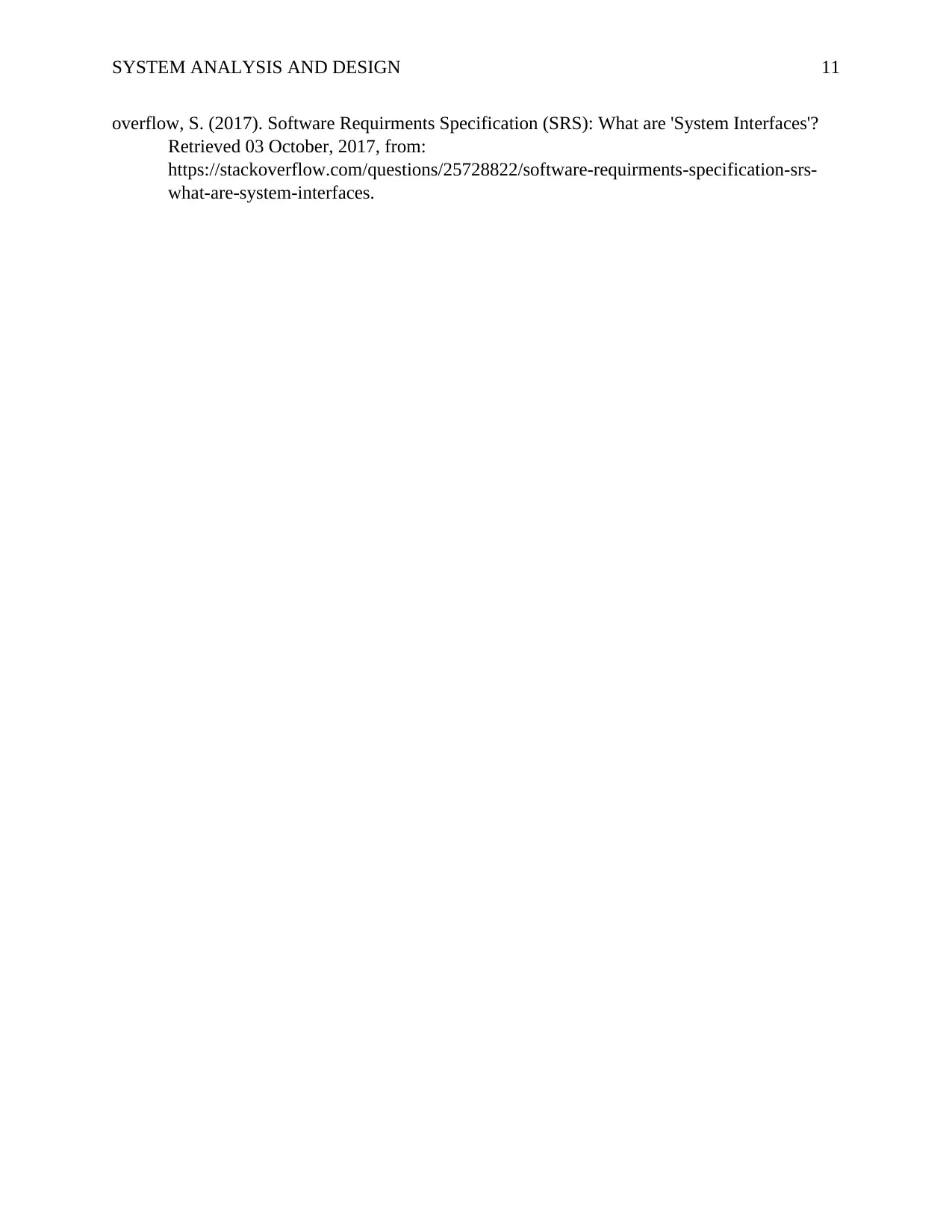
SYSTEM ANALYSIS AND DESIGN 11
overflow, S. (2017). Software Requirments Specification (SRS): What are 'System Interfaces'?
Retrieved 03 October, 2017, from:
https://stackoverflow.com/questions/25728822/software-requirments-specification-srs-
what-are-system-interfaces.
overflow, S. (2017). Software Requirments Specification (SRS): What are 'System Interfaces'?
Retrieved 03 October, 2017, from:
https://stackoverflow.com/questions/25728822/software-requirments-specification-srs-
what-are-system-interfaces.
1 out of 11
Related Documents
Your All-in-One AI-Powered Toolkit for Academic Success.
+13062052269
info@desklib.com
Available 24*7 on WhatsApp / Email
![[object Object]](/_next/static/media/star-bottom.7253800d.svg)
Unlock your academic potential
© 2024 | Zucol Services PVT LTD | All rights reserved.





